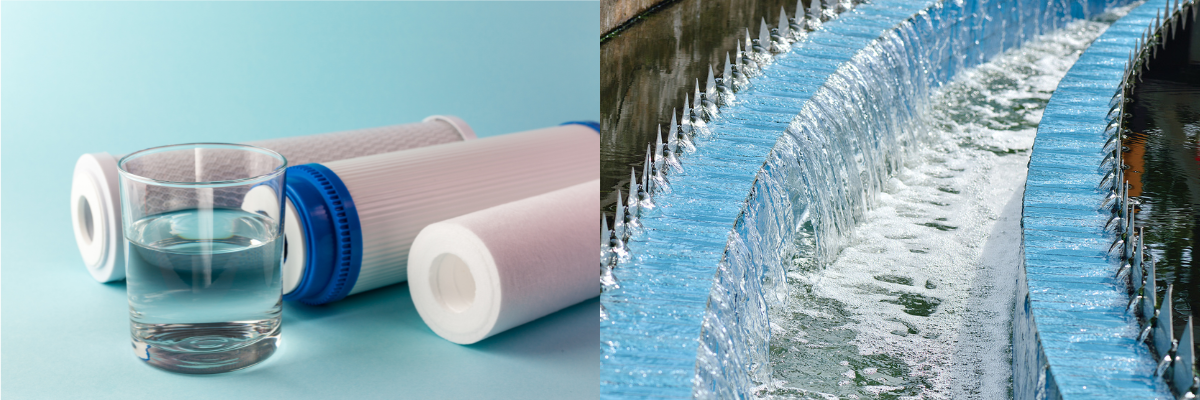As the demand for liquid filtration technology in modern industry surges, melt-blown fabric, with its exceptional performance, is emerging as one of the key materials in the industry. From its broad range of applications to its unique manufacturing process, this material demonstrates multiple advantages such as high-efficiency filtration, durability, and customization.

Ⅰ. Applications Across Various Industries
1. Water treatment
Melt-blown fabric is pivotal in environmental protection and resource optimization, owing to its superior filtration capabilities. In industrial wastewater treatment, melt-blown fabric serves as a pretreatment material, efficiently removing suspended particles and grease, thereby alleviating the burden on subsequent processes and safeguarding reverse osmosis membrane modules from contamination by particulate matter, ultimately enhancing overall treatment efficiency. In household water purification systems, melt-blown fabric functions as the core filter medium, leveraging its superior filtration capabilities to provide consumers with safe and pure drinking water.
2. Food and Beverage
As a food-grade material, melt-blown fabric is the optimal choice for filtering liquids like fruit juices, beer, and milk. It guarantees the purity of taste through microparticle filtration and reduces the risk of microbial contamination in the manufacturing process.
3. Petrochemical
In the precision filtration of lubricating oils, fuels, and other chemical products, PBT melt-blown fabric's resistance to high temperatures and oxidation ensures superior performance in environments characterized by heat and high oxidative chemicals.
4. Medical and Pharmaceutical
The high filtration efficiency, high dirt-holding capacity, and excellent biocompatibility of Kingfa's melt-blown fabric meet the stringent industry standards of the medical and pharmaceutical sectors, providing high-quality protection for high-precision filters within filtration systems.
5. High-End Coatings and Ink Production
Melt-blown fabric effectively captures impurities in raw materials, enhancing the uniformity of coatings, which in turn optimizes the coating effect and extends the lifespan of equipment.
Ⅱ. Technical Principles and Process Innovations of Kingfa's Melt-blown Fabric
The high performance of Kingfa's liquid filtration melt-blown fabric stems from its advanced melt blowing manufacturing process, the core of which lies in:
Ultrafine Fibers: The Kingfa melt-blowing process involves melting polymer materials (such as polypropylene and polyethylene terephthalate) at high temperatures and ejecting the molten material through high-speed hot air to form ultrafine fibers with diameters ranging from 1 to 5 micrometers. These fibers construct a dense and highly uniform network structure, significantly enhancing filtration efficiency.
Random Fiber Distribution for Enhanced Structural Stability: The fibers in Kingfa's melt-blown fabric are randomly arranged, providing higher porosity and more stable physical strength compared to traditional woven materials. This allows the fabric to maintain structural integrity over extended periods when subjected to liquid impact.
Innovative Post-processing Techniques: The melt-blown fabric can undergo post-processing techniques such as surface coating, electret treatment, hydrophilic or hydrophobic treatment to further optimize filtration performance, extend service life, and meet specific industry standards.
Ⅲ. Core Technical Advantages of Kingfa's Melt-blown Fabric
1. Exceptional Filtration Precision and Efficiency: With small fiber diameters and uniform distribution, it efficiently captures micrometer-sized particles and even sub-micrometer contaminants. Under specific test conditions, the filtration efficiency for particles of a specific size can reach over 90%.
2. High Porosity for Reduced Pressure Drop: The porosity of the melt-blown fabric can reach 70%-85%, enhancing material throughput and effectively reducing pressure loss when liquids pass through. This is particularly important for filtration systems requiring continuous high-flow operation.
3. Excellent Chemical Resistance and Corrosion Resistance: By selecting different polymer raw materials and employing modification techniques, the melt-blown fabric maintains long-term stability in acidic, alkaline, and organic solvent environments.
4. Strong Customization Capabilities: Parameters such as air permeability, pore size distribution, and functional characteristics of the melt-blown fabric can be adjusted according to customer needs, catering to various application scenarios ranging from general industry to high-end medical use.
Ⅳ. Prospective Outlook
Looking into the future, the realm of melt-blown fabrics promises a series of compelling development trends. While retaining its core filtration capabilities, the industry will explore multifaceted modification technologies, integrating features like antibacterial, antistatic, and enhanced adsorption to meet specialized industry needs.
In line with the growing emphasis on environmental conservation, the melt-blown fabric industry will endeavor to embrace more eco-conscious raw materials, notably biodegradable and recycled ones, thereby fostering green transformation and sustainable development within the sector.
The fusion of intelligent technology marks another pivotal advancement. By seamlessly integrating with online monitoring sensors, it facilitates real-time tracking of filtration efficiency and lifespan, further accelerating the progression toward smart industries.




